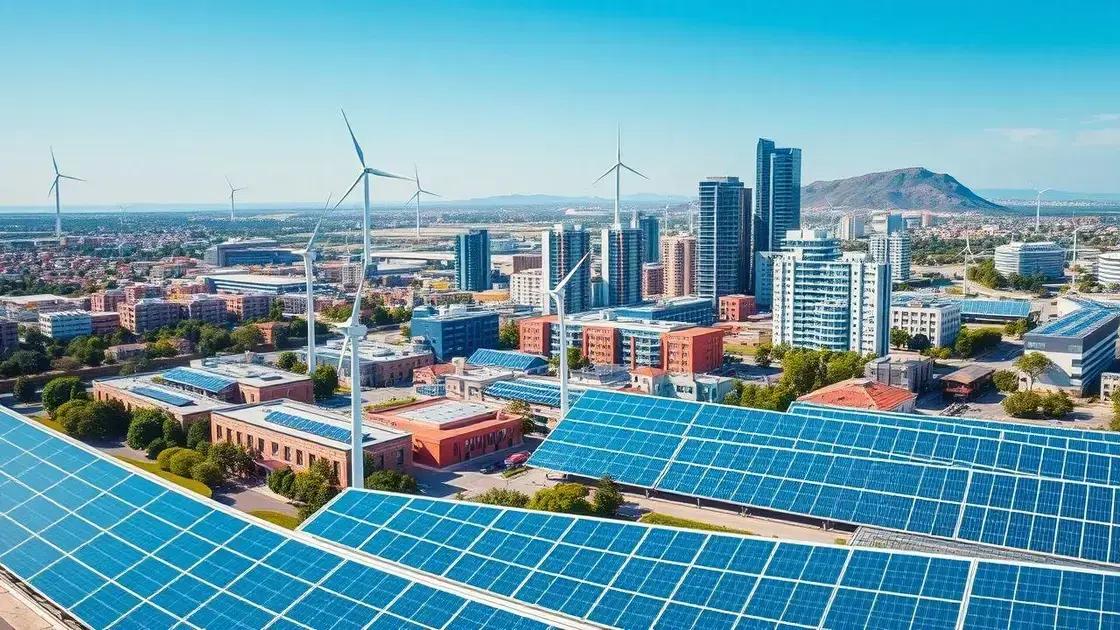Impact of U.S. green tech subsidies on startups
The impact of U.S. green tech subsidies on startups includes enhanced innovation opportunities, financial support for development, and essential resources to navigate challenges in creating sustainable technologies.
The impact of U.S. green tech subsidies on startups is significant, influencing both innovation and market dynamics. How do these financial incentives shape the future of emerging companies? Let’s dive into this crucial topic.
Overview of green tech subsidies in the U.S.
When we talk about the overview of green tech subsidies in the U.S., it’s essential to understand their role in promoting sustainability and innovation. These subsidies aim to encourage companies to develop clean technologies and energy solutions.
In the United States, various forms of support exist, including tax incentives and grants, which significantly impact the growth of green startups. Startups can leverage these funds to enhance their research and development, making it easier to bring innovative solutions to market.
Types of Green Tech Subsidies
Different types of subsidies are available for green tech initiatives. Here are some notable examples:
- Tax Credits: These reduce the amount of tax owed for companies investing in renewable energy projects.
- Grants: Financial gifts that do not require repayment, often funding specific projects or research.
- Loan Guarantees: Government-backed loans that reduce financial risk for startups.
- Investment Programs: Initiatives that promote public and private sector investments in green technologies.
These subsidies are designed not only to foster innovation but also to create jobs within the green sector. As a result, startups have greater access to essential resources to pioneer new ideas using renewable energy.
Furthermore, the competitive landscape for these subsidies drives companies to develop practical, environmentally friendly solutions. With the growing concerns about climate change, the need for green technology has never been more crucial.
Importance of These Subsidies
The importance of green tech subsidies cannot be overstated. They serve as a critical catalyst in accelerating the transition to a sustainable economy. By providing financial support, the government plays a vital role in promoting environmentally friendly practices.
Moreover, these incentives help level the playing field for smaller firms, allowing them to compete with larger companies that may have more resources. As such, green tech subsidies contribute to a diverse and innovative marketplace.
In summary, the overview of green tech subsidies in the U.S. highlights their significance in supporting startups and encouraging the development of sustainable solutions. By understanding these dynamics, investors and entrepreneurs can make informed decisions when engaging with the green tech landscape.
How subsidies boost startup innovation

Subsidies play a crucial role in how startups innovate and grow. By providing financial support, they enable new businesses to explore creative ideas without the burden of high initial costs. When startups receive these funds, they can focus more on research and development, which often leads to breakthrough technologies.
One of the main effects of subsidies is the ability to experiment. Startups can take risks and innovate, knowing that some expenses are covered. This freedom encourages an entrepreneurial spirit, leading to diverse solutions in the green tech sector.
Creating Opportunities for Growth
Subsidies not only support innovation but also create valuable opportunities for startups. With enhanced funding, businesses can:
- Develop New Technologies: Access to funds allows startups to create prototype products that could change the industry.
- Hire Talent: More resources mean the ability to attract skilled specialists who bring creative solutions.
- Expand Market Reach: Financial support can help startups enter new markets and reach more customers.
- Enhance Marketing Efforts: With additional funds, startups can effectively promote their green technologies and attract investors.
Moreover, the competition spurred by these subsidies compels startups to continually improve their offerings. As they race to innovate, exciting advancements emerge in sustainability. This not only benefits individual startups but also enhances the overall market with fresh ideas.
Additionally, the collaboration among startups supported by subsidies fosters a unique ecosystem. By sharing knowledge and resources, these startups can amplify their impact, resulting in significant technological advancements. The supportive environment allows them to tackle challenges more effectively.
Long-term Impact on Innovation
The long-term effect of subsidies on innovation cannot be ignored. Over time, these financial aids can shift entire industries towards sustainable practices. The cumulative effect of many innovative startups can lead to broader societal changes.
In the end, understanding how subsidies boost startup innovation reveals the potential for a greener future. Financing encourages entrepreneurs to think creatively and engage in meaningful projects that address crucial environmental issues, paving the way for a sustainable economy.
Challenges startups face with subsidies
While subsidies are beneficial for green tech startups, they also present certain challenges. Understanding these hurdles is essential for entrepreneurs looking to navigate this landscape. Some startups may struggle to meet the eligibility requirements for funding, which can be complex and time-consuming.
Documentation and compliance can also pose significant hurdles. Startups must dedicate valuable resources to ensuring they meet all requirements, redirecting focus from innovation to administration. This shift can slow down progress and lead to frustration.
Common Challenges Faced
Startups often encounter several common challenges when dealing with subsidies:
- Application Complexity: The application process can be lengthy and require extensive documentation, which may deter smaller startups.
- Competition for Funds: Many startups compete for limited resources, making it challenging to secure the necessary funds.
- Regulatory Compliance: Startups must adhere to specific regulations and guidelines, adding additional pressure to their operations.
- Funding Uncertainty: The availability of subsidies can fluctuate, creating uncertainty for startups relying on these funds.
These challenges highlight the importance of strategic planning for startups. Being prepared for the complexities of the subsidy landscape can help companies maintain focus on their core business objectives. Effective management and the ability to adapt to changing circumstances are vital.
Furthermore, startups.must consider the impact of these challenges on their short-term and long-term strategies. Building a strong support network, including mentors and advisors familiar with the subsidy process, can provide valuable guidance. Sharing experiences with other startups can lead to finding solutions collectively, making it easier to navigate obstacles.
Navigating the Challenges
To succeed despite the challenges, startups can adopt specific strategies. They can invest time in understanding the subsidy landscape and actively seeking feedback on their applications. Additionally, collaborating with organizations that specialize in green tech can provide insights and make the process smoother.
Ultimately, recognizing and addressing the challenges that come with subsidies allows startups to focus on their innovation goals while still benefiting from the support available within the green tech ecosystem. By being proactive and resourceful, these companies can overcome hurdles and leverage funding more effectively.
Future trends in U.S. green tech funding

The future trends in U.S. green tech funding indicate a strong shift towards sustainability and innovation. As environmental concerns grow, more investors are looking to support startups that focus on renewable energy and clean technologies. This trend suggests an increasingly competitive market where investment will play a critical role.
Investment in green technology is expected to expand significantly in the coming years. With government policies favoring renewable energy, there are promising signs for startups that align their goals with these initiatives. As awareness of climate change increases, funding for eco-friendly projects is likely to grow as well.
Emerging Funding Sources
Startups may find new and diverse funding sources in the future. Some of these include:
- Venture Capital: More venture capital firms are focusing on sustainable technology, providing needed capital for innovative ideas.
- Crowdfunding: Platforms dedicated to environmentally focused projects can help startups raise funds directly from supporters.
- Corporate Partnerships: Larger corporations may partner with startups to leverage new green technologies, offering both funding and resources.
- Impact Investing: Investors looking for social and environmental returns are increasingly funding green ventures.
As funding sources evolve, the landscape for green tech startups will change rapidly. Companies that adapt will likely find better chances for success. Investors are actively seeking opportunities to back technologies that contribute to a sustainable future.
Moreover, as technology advances, we can expect an increase in innovation around existing products and solutions. Startups might develop smarter energy systems or more efficient manufacturing processes that minimize waste. These innovations could attract even more funding as they demonstrate their viability and potential impact.
Government Policies and Incentives
The government will also play a crucial role in shaping the funding environment. New policies may introduce additional incentives for green tech investments. This support could include tax breaks for investors or grants for startups engaged in sustainable practices.
Overall, understanding the future trends in U.S. green tech funding allows startups to prepare effectively. By staying informed about potential funding sources and adapting to new technologies and regulations, startups can secure the financial backing they need to thrive in a rapidly changing market. Those who capitalize on these trends will lead the charge towards a more sustainable and innovative future.
| Key Takeaways 🌿 | |
|---|---|
| Funding Opportunities 💰 | Startups can explore various funding sources to drive innovation. |
| Regulatory Changes ⚖️ | Understanding policies will help startups adapt and succeed. |
| Challenges Faced 🚧 | Startups must navigate complex applications and competition. |
| Future Trends 🚀 | Funding for green tech is expected to expand with time. |
| Impact on Environment 🌍 | Green tech startups contribute to a more sustainable future. |
FAQ – Frequently Asked Questions about U.S. Green Tech Subsidies for Startups
What types of subsidies are available for green tech startups?
Green tech startups can access various subsidies, including tax credits, grants, loan guarantees, and investment programs.
How do subsidies boost startup innovation?
Subsidies provide financial support that allows startups to focus on research, development, and innovative solutions without worrying about initial costs.
What challenges do startups face when applying for subsidies?
Startups often encounter application complexity, competition for funds, regulatory compliance, and uncertainty in funding availability.
What future trends can we expect in green tech funding?
Future trends indicate an increase in diverse funding sources, government incentives, and a growing interest in sustainable investment from venture capitalists.





